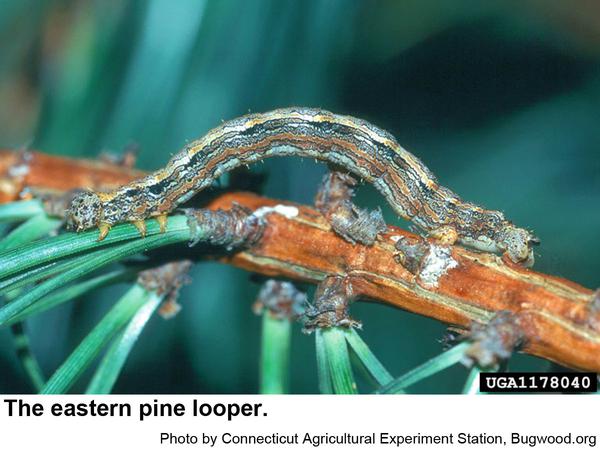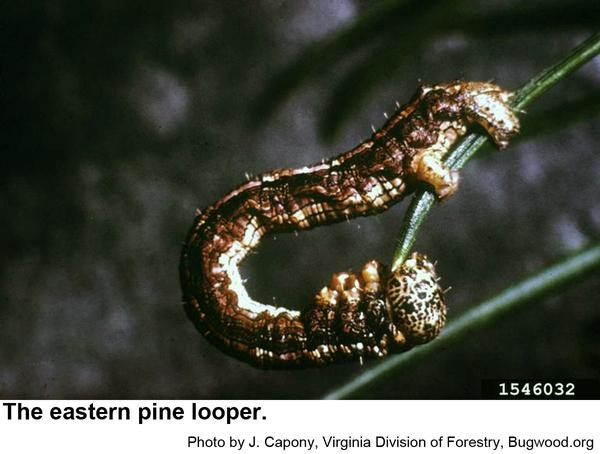Description and Biology
The eastern pine looper, Lambdina pellucidaria, is a species whose immatures feed as loopers on yellow pine needles. It is also called the pitch pine looper and the yellow-headed looper. The loopers are mottled brown and gray with brown and gray mottled stripes along the body. The head is realtively large and has brown and black spots. The first three pairs of legs are yellowish. The two pairs of abdominal legs are mottled. These caterpillars grow to about 11/4 inch long and crawl about with a looping motion. Eastern pine loopers occur from August to November. When mature, the caterpillars descend to the duff and pupate there or in soil. Pupae are relatively slender and turn dark brown. The moths are mottled brown to gray and have a darker line across the wing as well as some darker wing veins. The wingspan is up to 11/2 inch wide. The moths emerge from the pupae the following May and lay oval, pale green eggs that turn yellowish to tan eggs in batches along pine needles until the end of June. This looper is found throughout North Carolina where it has one generation per year.
Host Plants
Eastern pine loopers feed on pitch pine, red pine, and other hard pines. It has also been reported to feed on oak (which seems like a stretch to me). These loopers chew out only a portion of a needle, which then turns brown. If an infestation is heavy and persists for 2 or 3 years, such defoliation may kill pines.
Residential Recommendations
Rarely do eastern pine loopers become abundant enough to even be noticed, although at times they have caused local defoliation of pines. If a specimen tree is small enough to spray, it should be possible to eliminate the loopers with a single application of a pyrethroid or another pesticide labeled for caterpillar control in residential landscapes. When used as directed, pyrethroids are very toxic to insects but are not particularly hazardous to humans and pets (other than fish—avoid using pyrethroids around pools, ponds, and streams). Such pesticides are available in the garden section of big box stores and in plant centers and nurseries.
Other Resources
- Pitch Pine Looper (Lambdina pellucidaria). Griffin, E. 2010 (last modified). BugwoodWiki.
- Insects of Eastern forests. Drooz, A. T. editor. 1985. USDA Forest Service Misc. Publication 1426. 608 pp.
- Extension Plant Pathology Publications and Factsheets
- Horticultural Science Publications
- North Carolina Agricultural Chemicals Manual
For assistance with a specific problem, contact your local N.C. Cooperative Extension Center.
This Factsheet has not been peer reviewed.
Publication date: May 14, 2020
Reviewed/Revised: March 7, 2025
Recommendations for the use of agricultural chemicals are included in this publication as a convenience to the reader. The use of brand names and any mention or listing of commercial products or services in this publication does not imply endorsement by NC State University or N.C. A&T State University nor discrimination against similar products or services not mentioned. Individuals who use agricultural chemicals are responsible for ensuring that the intended use complies with current regulations and conforms to the product label. Be sure to obtain current information about usage regulations and examine a current product label before applying any chemical. For assistance, contact your local N.C. Cooperative Extension county center.
N.C. Cooperative Extension prohibits discrimination and harassment regardless of age, color, disability, family and marital status, gender identity, national origin, political beliefs, race, religion, sex (including pregnancy), sexual orientation and veteran status.







